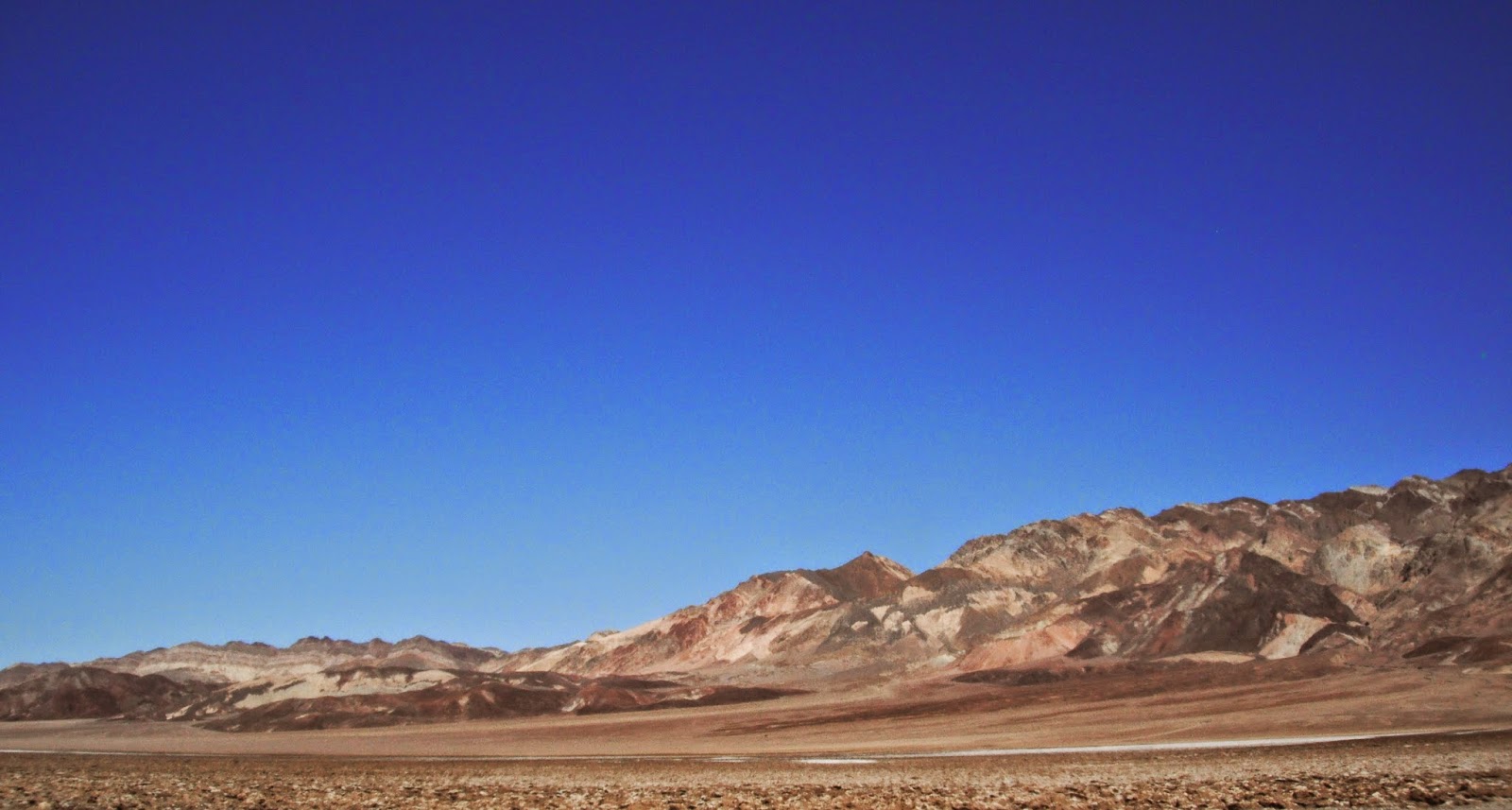 |
| The Panamint Mountains |
This is one place that we said, even before we left there, that we would come back to. There are precious few of those in our travels. We tend to go and see and press on to the next place. But this one; no matter how long you stay or how much you explore leaves you wanting more.
We had just spent several weeks in Las Vegas and upon leaving we headed north west on U.S. Highway 95 before turning at Beatty onto NV 374 to drop into the Valley from the east side through Daylight Pass.
 |
| Gateway to the park from Hwy 95 on east side. |
The first thing we noticed as we descended into the Valley proper was the smell. No mistaking it, the very distinctive odor of brakes a'la char was wafting into the cab. Time to stop - or try to - and enjoy the sweeping vistas while she cools down a bit. The road in is a long, gradual grade that suddenly gets to 9% just when you start letting your guard down. Bad juju towing a trailer. So we coasted to a stop in the first wide spot we saw. I was so glad we did. "Sweeping vista" is utterly inadequate to describe it.
 | ||||
| Cooling our heels, er, brakes. |
The view before us was spectacular. 'nuff said - just look:
 | |
| Death Valley beckoning us in. |
As night was closing in we headed down into the valley proper to find a campsite and fix some dinner. That first night we set up camp at the Furnace Creek Campground.
 |
| Furnace Creek Campground, Death Valley NP |
just as we were finishing up dinner a friendly Park Service Ranger came by and told us he would be doing a talk on the history of the Valley in the nearby amphitheater. This sounded too good to miss so we gathered our water bottles and headed on over. It was a great talk, he told us all about the early days of the valley, the borax mines and the 20 mule teams. How the natives lived and the current efforts to keep the Valley wild and still accessible to all. NPS Ranger talks are one of the best things about our parks, if you get a chance to attend one by all means do so!
The next day we set out to explore and our first stop was the Borax Works.
From the NPS website:
"Harmony Borax Works was the central feature in the opening of Death Valley and the subsequent popularity of the Furnace Creek area. The plant and associated townsite played an important role in Death Valley history.
After borax was found near Furnace Creek Ranch (then called Greenland) in 1881, William T. Coleman built the Harmony plant and began to process ore in late 1883 or early 1884. When in full operation, the Harmony Borax Works employed 40 men who produced three tons of borax daily. During the summer months, when the weather was so hot that processing water would not cool enough to permit the suspended borax to crystallize, Coleman moved his work force to the Amargosa Borax Plant near present day Tecopa, California.
Getting the finished product to market from the heart of Death Valley was a difficult task, and an efficient method had to be devised. The Harmony operation became famous through the use of large mule teams and double wagons which hauled borax the long overland route to Mojave.The romantic image of the “20-mule team” persists to this day and has become the symbol of the borax industry in this country.
The Harmony plant went out of operation in 1888, after only five years of production, when Coleman’s financial empire collapsed. Aquired by Francis Marion Smith, the works never resumed the boiling of cottonball borate ore, and in time became part of the borax reserves of the Pacific Coast Borax Company and it successors. On December 31, 1974, the site was placed on the National Register of Historic Places."
To be continued.....
After borax was found near Furnace Creek Ranch (then called Greenland) in 1881, William T. Coleman built the Harmony plant and began to process ore in late 1883 or early 1884. When in full operation, the Harmony Borax Works employed 40 men who produced three tons of borax daily. During the summer months, when the weather was so hot that processing water would not cool enough to permit the suspended borax to crystallize, Coleman moved his work force to the Amargosa Borax Plant near present day Tecopa, California.
Getting the finished product to market from the heart of Death Valley was a difficult task, and an efficient method had to be devised. The Harmony operation became famous through the use of large mule teams and double wagons which hauled borax the long overland route to Mojave.The romantic image of the “20-mule team” persists to this day and has become the symbol of the borax industry in this country.
The Harmony plant went out of operation in 1888, after only five years of production, when Coleman’s financial empire collapsed. Aquired by Francis Marion Smith, the works never resumed the boiling of cottonball borate ore, and in time became part of the borax reserves of the Pacific Coast Borax Company and it successors. On December 31, 1974, the site was placed on the National Register of Historic Places."
To be continued.....









No comments:
Post a Comment